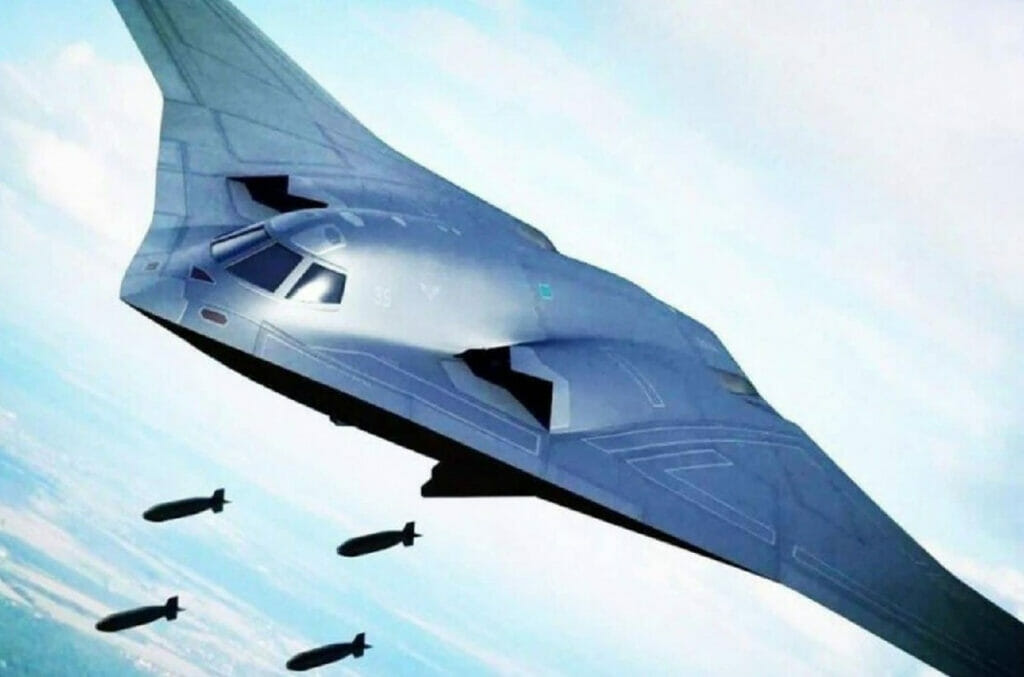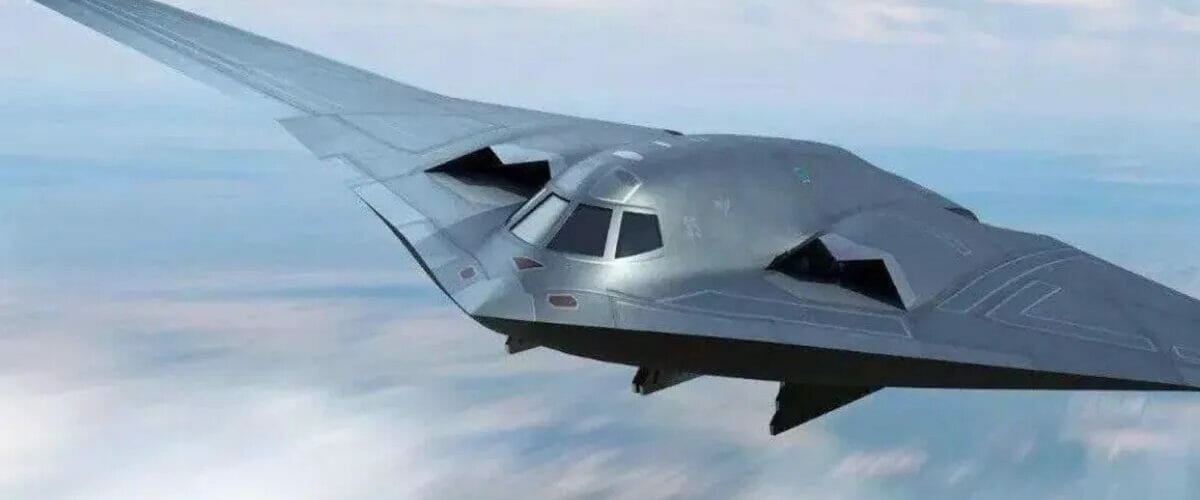The following report is by The Asia Times, published on July 14th, 2022:
China’s first intercontinental deep strike bomber, the H-20, is apparently nearing its first flight, according to news reports.
Publicly available information on the H-20 is scant due to its classified nature. Recent Chinese reports have only mentioned the coming of a specific type of aircraft of strategic and historical significance.
But photos released by China North Industries Corporation, or Norinco, in its Modern Weaponry monthly magazine show that the fighter has a flying wing design, a weapons bay, two adjustable tail wings and a frontal airborne radar
It also has stealth air intakes on both sides and is covered in dark grey radar-absorbent material, according to the same images.
The Warzone notes that the H-20 may have a 4,000 to 5,000-mile combat radius and can carry a wide range of precision-guided weapons such as smart bombs, land-attack cruise missiles and anti-ship missiles.
It will reportedly have a maximum takeoff weight of 200 tons, a payload of 45 tons and fly at high subsonic speeds.

Defense website 1945 notes that China aims to have the H-20 at operational capability by the end of the decade, roughly matching the US’ timeline for its B-21 Raider, the successor to the vaunted B-2 Spirit stealth bomber.
Military Watch mentions while the PLA Air Force (PLA-AF) was responsible for most of China’s early nuclear testing, its strategic nuclear deterrent is built around the PLA Rocket Force (PLA-RF) and PLA Navy (PLA-N) using a variety of land and sea-based ballistic missiles.
Although China is one of three countries that operates strategic bombers, along with the US and Russia, its long-range bomber force is notably laggard, as its mainstay Xian H-6 is based on the 1950s Soviet Tupolev Tu-16 bomber, as noted in a 2020 paper by the Hoover Institution think tank.
The paper notes that while the H-6 is an aging design, it has modern engines with the latest H-6N variant capable of mounting air-launched cruise missiles (ALCM) for standoff strike missions.
While Military Watch notes that the H-6N variant can carry nuclear-tipped, air-launched ballistic missiles (ALBM), most US analysts view it as a long-range ship hunter against US carrier battlegroups.
It also notes that the H-6 is considered a theater bomber with a tactical role, which means that without aerial refueling and standoff missiles it cannot strike targets at intercontinental ranges, unlike the US B-52 and B-2 and the Russian Tu-95 and Tu-160.
In September 2020, the PLA Air Force released a video showing an H-6N launching ALCMs at US Naval Base Guam, hinting that such long-range strikes against US forces and facilities in the Pacific may be its primary mission, instead of being a long-range ship hunter as previously thought of by US analysts.
But China’s present air and naval capabilities may be insufficient to support the H-6N in a long-range strike role. A 2019 study by the Center for Land Warfare Studies (CLAWS) notes that the range limitations of China’s current fighters mean that H-6N bombers are vulnerable to US, Japanese and Taiwanese air defenses before they can get within striking range of Guam.
It also mentions that China does not yet have maritime or carrier battlegroup support for long-range bombers in air defense at the open sea. However, this situation may have changed with the commissioning of the Type 055 cruisers equipped with powerful long-range air defense radars and long-range surface-to-air missiles.
The CLAWS study also notes that China has yet to master stealth technology, and consequently, US bases in the First and Second Island Chains continue to deter China’s long-range bomber flights.
In addition, US bases in South Korea, Japan, Guam and Hawaii may sport long-range air and missile defenses such as the Patriot, Aegis Ashore and Terminal High Altitude Area Defense (THAAD), which can threaten China’s H-6N bombers.
The study notes that the PLA Air Force’s most significant capability gap is the lack of a nuclear mission, which the H-20 is designed to perform. It also notes that the US has no established defenses against stealth aircraft, a fact that the H-20 may also seek to exploit.
A 2021 paper published by the Bulletin of the Atomic Scientists notes that the H-20 aims to replace the H-6N and can be equipped with nuclear-tipped ALCMs, completing China’s nuclear triad and increasing its operational flexibility in a contingency scenario.
Apart from completing China’s nuclear triad, the H-20 may perform aerial shows of force against China’s adversaries.
A 2018 study by RAND notes that China has been conducting long-range bomber overflights over the Pacific for four main reasons, with the H-20 enabling China to reliably threaten US targets beyond the First and Second Island Chains and advancing China’s air power projection capabilities.
First, H-20 bomber overflights over disputed maritime areas such as the South China Sea and Senkaku Islands show China’s resolve to defend these territories against potential adversaries such as Japan, Vietnam, and the Philippines, as it is not clear how these potential regional adversaries can counter a threat such as the H-20.
Second, the overflights provide training opportunities for PLA-AF pilots, providing realistic environments in which they may be expected to operate in a conflict scenario with the US. H-20 practice flights may feature tactics, techniques and procedures to exploit gaps in the Pacific region’s US and allied air defenses.
Third, long-range bomber flights with the H-20 can become showpieces of China’s growing military and economic might for domestic audiences, thereby increasing the legitimacy of the Chinese Communist Party in the eyes of the Chinese people.
Finally, the H-20 may feature in bomber overflights within and around Taiwan’s air defense identification zone (ADIZ) as part of China’s efforts to pressure the Taiwanese leadership to keep in line with China’s interests, dissuade any ideas for independence, and expose Taiwan’s military vulnerability by underscoring the inability of the US to assist in the event of an invasion.
AUTHOR COMMENTARY
As these psychopaths around the world continue to try and foment World War III, China appears to be gearing up for nuclear war as well.
[7] And when ye shall hear of wars and rumours of wars, be ye not troubled: for such things must needs be; but the end shall not be yet. [8] For nation shall rise against nation, and kingdom against kingdom: and there shall be earthquakes in divers places, and there shall be famines and troubles: these are the beginnings of sorrows. Mark 13:7-8
The WinePress reported last year that Russia and China announced a new alliance together to lead the “new world order.”
SEE: China And Russia Announce They Are Ready To Create A New World Order Together
[7] Who goeth a warfare any time at his own charges? who planteth a vineyard, and eateth not of the fruit thereof? or who feedeth a flock, and eateth not of the milk of the flock? [8] Say I these things as a man? or saith not the law the same also? [9] For it is written in the law of Moses, Thou shalt not muzzle the mouth of the ox that treadeth out the corn. Doth God take care for oxen? [10] Or saith he it altogether for our sakes? For our sakes, no doubt, this is written: that he that ploweth should plow in hope; and that he that thresheth in hope should be partaker of his hope. (1 Corinthians 9:7-10).
The WinePress needs your support! If God has laid it on your heart to want to contribute, please prayerfully consider donating to this ministry. If you cannot gift a monetary donation, then please donate your fervent prayers to keep this ministry going! Thank you and may God bless you.








I make over 13k a month working part-time. I listened to different humans telling me how a good deal of cash they may make online,N255 so I was determined to locate out. Well, it turned into all actual and it absolutely modified my life. Everybody must try this job now by just using this site.. Paynet2.com